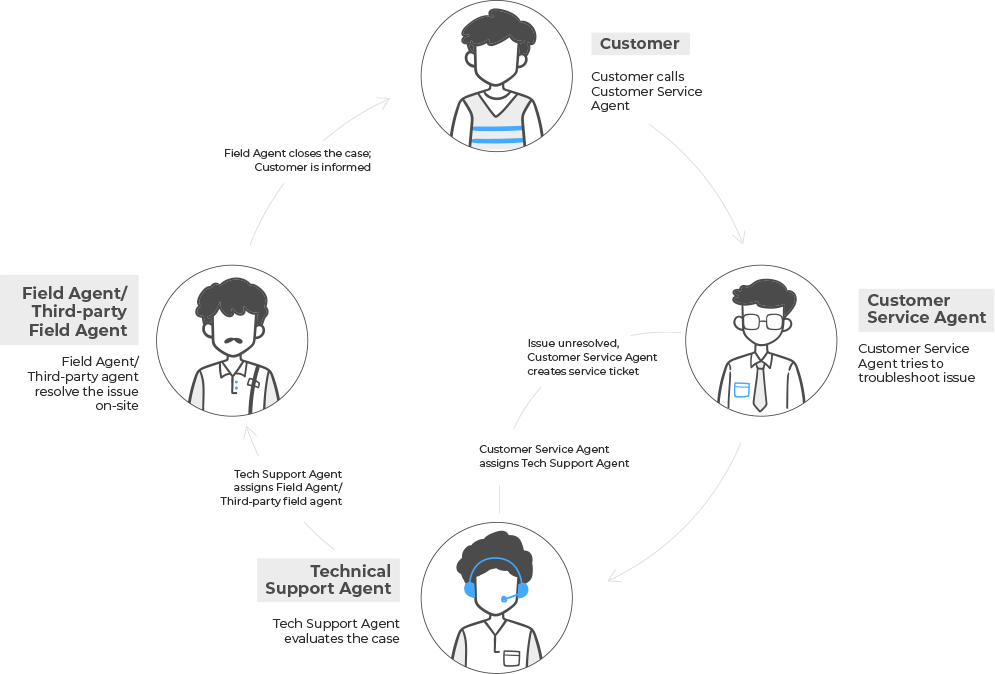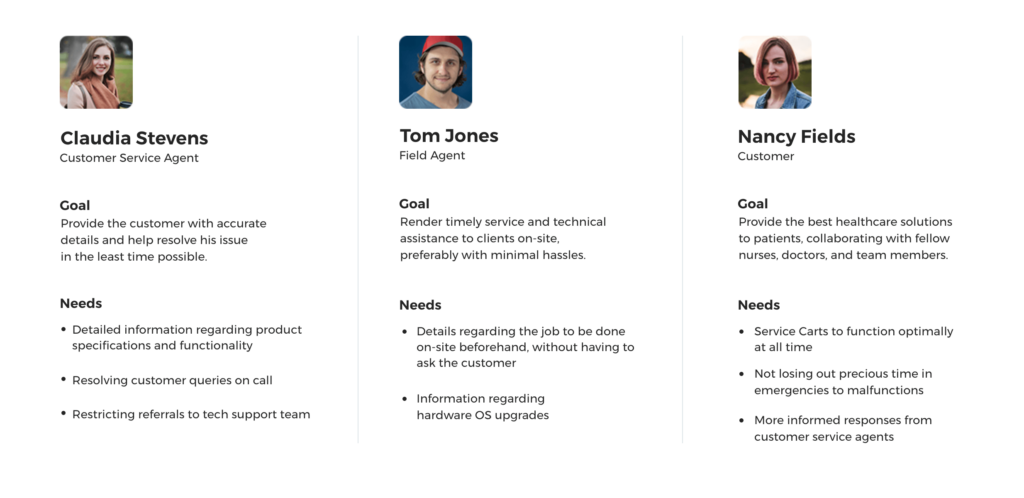-
Human-Computer Interaction (HCI)
Employing HCI to Eliminate Medicine Dispensing Machine Servicing Roadblocks
Workflow
What is the project background with reference to their workflow?
Our client is a leading North American company providing Point of Care and Medication Management solutions within the Healthcare domain. Their product inventory comprised a range of storage solutions to be used by hospital staff in locations across the region.
The client reached out to Koru to help evaluate and enhance the UX and UI of the pod replacement workflow of their medical inventory access carts used to dispense medication to patients in hospitals.
The existing pod replacement process created problems for the service technicians, the customer support staff, and the customers as there was a lot of back-and-forth communication that happened over resolving a single complaint.

Their workflow featuring the customers, on-site service technicians, and customer support staff was broken and incohesive. This resulted in the scheduling of site visits for matters that could have been resolved remotely. It also led to scheduling disruptions for the service technicians and delayed crucial site visits.
The contracted service technicians would have to spend extended hours at sites as a result of the time-consuming manual pod replacement process. This would have a domino effect and delay subsequent site visits.
The overworked service staff would manage to complete a limited number of service requests per day, resulting in disgruntled customers and results of loss of revenue.
Problem Statement
Assess the existing pod replacement process to identify opportunities to optimize and simplify it by eliminating –
- extensive manual intervention
- the need for expert service technicians
- unstandardized workflows
- poor customer experience
UX Strategy
Journey mapping is a compilation of user goals and actions into a timeline. It conveys insightful details that add value to the design process. This journey map would help stakeholders gain a bird’s eye view of the entire service workflow.
We started by conducting interviews with all the users involved in the workflow – the customers, service technicians, and customer support staff.
This, along with periodic consultations with stakeholders helped collate information that helped in understanding the current process from the service providers’ and customers’ perspectives to build a comprehensive process map and customer journey map.
Methods used
- Stakeholder interviews
- Journey mapping
- Observational studies
- Product & ecosystem’s evaluation & analysis
The journey mapping exercise helped us understand not just the workflow of the customer support and field agents, but also the hardware (storage unit) and the way it is put into use by the nurses and technicians. Inconsistent and fragmented user journeys cause mounting frustration and impact the bottom line of the company.
Key Personas
Synthesis
What were the key problems discovered in the pod replacement process?

User-focused
- Requires the user to perform repetitive steps:
The replacement process of the pod drawer involves manual removal, adding the medication, and reconfiguring the replaced hardware.
- The process is time-consuming
The user adds the inventory and configuration, one unit at a time, and may have to spend more time waiting for a system upgrade.
Process-focused
- Users are required to connect with 2-3 points of contact to build context
Coordination with stakeholders about the delivery of the replacement hardware and with remote help to upgrade OS if required which would take 3 to 4 hours. If the technical help was busy/unavailable, it would add to the wait time.
Product-related
- Customers often connect unsupported gadgets like phone chargers and portable fans to the USB provided for the auxiliary unit that damages the circuit.
- Some users tend to slam the drawers, causing them to malfunction.
- Access cart fails to detect the new hardware post the upgrade.
Documentation-related
- Lack of documentation or checklist shared with the customer to prep for the activity
Reminder about the replacement activity
Request to empty the drawer/pod prior to the visit
Informing the customer about the estimated downtime
Coordination with the pharmacy department for the availability of their representative
Protocol to be followed while doing a replacement activity
Manual documentation of medication inventory
- Additional causes
Time estimation prior to visit is subject to largely vary due to factors like:
OS upgrade requirements.
Faulty functioning of the hardware due to damage caused by poor usage.
Unavailability of remote assistance like ‘Interface Specialist’.
Ideation
Once we synthesized the data received, we could clearly identify that the key pain areas revolved around two aspects of the process
- Repetitive tasks
- Added time consumption
Brainstorming
On review of the process, key activities that contributed to the prominent findings were:
- Removing medication
- Deleting configuration
- Adding medication
- Reconfiguring the device
The team focused on key problem areas in the context of the process and came up with ideas to simplify it. Two prominent themes from the session were –
- Ability to perform batch actions
Ability to empty multiple drawers/pods
Ability to select multiple pods/drawers and apply the same attributes to them
Easy copy/paste of data that is needed by the user - Change in process
Request the pharmacy rep to empty the drawers prior to the arrival of the technician as a prerequisite
Let the pharmacy refill the medication into the access cart once the mapping of drawers is successfully done
Design
With the identified focus areas from the research and synthesis process, the design team prototyped concepts that would focus on solving the above-listed problems
Impact
The new interface was able to deliver benefits for the technicians as well as the hospital personnel, such as –
Decreasing training costs of contracted technicians
Decreasing the time taken to resolve on-site issues
Reduction in the downtime of the carts
Fixing minor issues in a remote manner without having to call upon service technicians
Ready to make a difference with design?
Let’s talk about the infinite possibilities of a design thinking approach!















